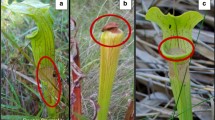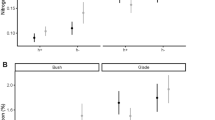Summary
The effects of defoliation on growth and nitrogen (N) nutrition were examined in populations of Agropyron smithii (western wheatgrass) collected from a heavily grazed black-tailed prairie dog (Cynomys ludovicianus) colony (ON-colony) and a nearby lightly grazed, uncolonized area (OFF-colony). Defoliated and nondefoliated plants were grown at low soil N availability with similar sized defoliated individuals of A. smithii from a grazing-exclosure population as a common competitor. Sequential harvests were made over 24 days following defoliation. Growth analysis plus biomass and N yield and distribution data were used to identify features which may contribute to plant defoliation tolerance. Defoliation reduced total production 34% across populations. Defoliated plants produced as much new blade tissue, but only 67% as much new root biomass as did nondefoliated controls. Plants from prairie dog colonies accumulated biomass at a faster relative rate than did plants from uncolonized sites, in part, because of a 250% greater mean relative growth rate of blades and more than 200% greater rate of biomass production per unit blade biomass. Total N accumulation was significantly greater in defoliated ON- than OFF-colony individuals. The mean relative accumulation rate of N was increased by defoliation in ON-colony plants, but reduced by defoliation in OFF-colony plants. The mean rate of N accumulation per unit root biomass was more than 300% greater in the ON- than OFF-colony population. Colony plants initially had a greater proportion of biomass and N remaining after defoliation in roots. Initial differences between populations in the distribution of biomass and N were eliminated as colony plants concentrated 24-day accumulation of biomass and N in aboveground structures. The data suggest that the combination of growth, N nutrition, and biomass and N distribution characteristics of the colony population likely confer a high rate of resource capture on heavily grazed prairie dog colonies.
Similar content being viewed by others
References
Archer S, Detling JK (1984) The effects of defoliation and competition on regrowth of tillers of two North American mixed-grass prairie graminoids. Oikos 43:351–357
Bokhari UG (1977) Regrowth of western wheatgrass utilizing 14C-labelled assimilates stored in belowground parts. Plant Soil 48:115–117
Carman JG, Briske DD (1985) Morphologic and allozymic variation between long-term grazed and non-grazed populations of the bunchgrass Schizachyrium scoparium var. frequens. Oecologia (Berlin) 66:332–337
Chapin FS III (1980a) Nutrient allocation and responses to defoliation in tundra plants. Arct Alp Res 12:553–563
Chapin FS III (1980b) The mineral nutrition of wild plants. Annu Rev Ecol Syst 11:233–260
Chapin FS III, Bieleski RL (1982) Mild phosphorus stress in barley and a related low-phosphorus-adapted barleygrass: Phosphorus fractions and phosphate absorption in relation to growth. Physiol Plant 54:309–317
Chapin FS III, Slack M (1979) Effect of defoliation upon root growth, phosphate absorption, and respiration in nutrient-limited tundra graminoids. Oecologia (Berlin) 42:67–79
Chapin FS III, Van Cleve K (1981) Plant nutrient absorption and retention under differing fire regimes. In: Mooney HA, Bonnicksen TM, Christensen NL, Lotan JE, Reiners WA (eds) Proceedings of the Conference: Fire Regimes and Ecosystem Properties. USDA For Serv Gen Tech Rep WO-26:301–321
Clarholm M (1985) Interactions of bacteria, protozoa and plants leading to mineralization of soil nitrogen. Soil Biol Biochem 17:181–187
Clarkson DT, Hanson JB (1980) The mineral nutrition of higher plants. Annu Rev Plant Physiol 31:239–298
Coppock DL, Detling JK, Ellis JE, Dyer MI, (1983a) Plant-herbivore interactions in a North American mixed-grass prairie. I. Effects of black-tailed prairie dogs on intraseasonal aboveground plant biomass and nutrient dynamics and plant species diversity. Oecologia (Berlin) 56:1–9
Coppock DL, Ellis JE, Detling JK, Dyer MI (1983b) Plant-herbivore interactions in a North American mixed-grass prairie. II. Responses of bison to modification of vegetation by prairie dogs. Oecologia (Berlin) 56:10–15
Dalsted KJ, Sather-Blair S, Worcester BK, Klukas R (1981) Application of remote sensing to prairie dog management. J Range Manage 34:218–223
Davidson JL, Milthorpe FF (1966) The effect of defoliation on the carbon balance in Dactylis glomerata. Ann Bot (London) 30:185–198
Detling JK, Painter EL (1983) Defoliation responses of western wheatgrass populations with diverse histories of prairie dog grazing. Oecologia (Berlin) 57:65–71
Detling JK, Dyer MI, Winn DT (1979) Net photosynthesis, root respiration, and regrowth of Bouteloua gracilis following simulated grazing. Oecologia (Berlin) 41:127–134
Detling JK, Painter EL, Coppock DL (1986) Ecotypic differentiation resulting from grazing pressure: evidence for a likely phenomenon. In: Joss PJ, Lynch PW, Williams OB (eds) Rangelands: a resource under siege. Proceedings of the Second International Rangeland Congress: Australian Academy of Science, Canberra, pp 431–433
Hoagland DR, Arnon DI (1950) The water-culture method for growing plants without soil. Calif Agric Exp Sta Circ 347
Hodgkinson KC, Williams OB (1983) Adaptation to grazing in forage plants. In: McIvor JG, Bray RA (eds) Genetic resources of forage plants. Commonwealth Scientific and Industrial Organization, East Melbourne, pp 85–100
Hunt R (1978) Plant growth analysis. The Institute of Biology's Studies in Biology, no 96. Arnold, London
Ingham RE, Detling JK (1984) Plant-herbivore interactions in a North American mixed-grass prairie. III. Soil nematode populations and root biomass on Cynomys ludovicianus colonies and adjacent uncolonized areas. Oecologia (Berlin) 63:307–313
Jaramillo VJ, Detling JK (1988) Grazing history, defoliation, and competition: effects on shortgrass production and nitrogen accumulation. Ecology (in press)
Kemp WB (1937) Natural selection within plant species as exemplified in a permanent pasture. J Hered 28:329–333
Krueger K (1986) Feeding relationships among bison, pronghorn, and prairie dogs: an experimental analysis. Ecology 67:760–770
McNaughton SJ (1984) Grazing lawns: animals in herds, plant form, and coevolution. Am Nat 124:863–886
McNaughton SJ, Chapin FS III (1985) Effects of phosphorus nutrition and defoliation on C4 graminoids from the Serengeti plains. Ecology 66:1617–1629
McNaughton SJ, Wallace LL, Coughenour MB (1983) Plant adaptation in a ecosystem context: effects of defoliation, nitrogen, and water on growth of an African C4 sedge. Ecology 64:307–318
Mahmoud A, Grime JP, Furness SB (1975) Polymorphism in Arrhenatherum elastius (L.) Beauv. Ex. J.&C. Presl. New Phytol 75:269–276
Marsh B a'B (1971) Measurement of length in random arrangement of lines. J Appl Ecol 8:265–267
Mengel K, Viro M (1978) The significance of plant energy status for the uptake and incorporation of NH4-nitrogen by young rice plants. Soil Sci Plant Nutr 24:407–416
Michael G, Martin P, Owassia I (1970) The uptake of ammonium and nitrate from labelled ammonium nitrate in relation to the carbohydrate supply of the roots. In: Kirkby EA (ed) Nitrogen nutrition of the plant. University of Leeds, pp 22–29
Mueggler WF (1972) Influence of competition on the response of bluebunch wheatgrass to clipping. J Range Manage 25:88–92
Nelson DW, Sommers LE (1980) Total nitrogen analysis of soil and plant tissue. Assoc Off Anal Chem J 63:770–778
Painter EL (1987) Grazing and intraspecific variation in four North American grass species. Ph.D. Thesis, Colorado State University
Peterson RA (1962) Factors affecting resistance to heavy grazing in needle-and-thread grass. J Range Manage 15:183–189
Quinn JA, Miller RV (1967) A biotic selection study utilizing Muhlenbergia montana. Bull Torrey Bot Club 94:423–432
Radford PJ (1967) Growth analysis formulae-their use and abuse. Crop Sci 7:171–175
Richards JH, Caldwell MM (1985) Soluble carbohydrates, concurrent photosynthesis and efficiency in regrowth following defoliation: a field study with Agropyron species. J Appl Ecol 22:907–920
Shaver GR, Melillo JM (1984) Nutrient budgets of marsh plants: efficiency concepts and relation to availability. Ecology 65:1491–1510
Steel RGD, Torrie JH (1980) Principles and procedures of statistics: a biometric approach, 2nd edn. McGraw-Hill, New York
Trlica MJ (1977) Distribution and utilization of carbohydrate reserves in range plants. In: Sosebee RE (ed) Rangeland plant physiology, Range Science Series No 4. Society for Range Management, Denver, Col., pp 73–96
Warwick SI, Briggs D (1979) The genecology of lawn weeds. III. Cultivation experiments with Achillea millefolium L., Bellis perennis L., Plantago lanceolata L., Plantago major L. and Prunella vulgaris L. collected from lawns and contrasting grassland habitats. New Phytol 83:509–536
Welbank PJ (1962) The effects of competition with Agropyron repens and nitrogen- and water-supply on the nitrogen content of Impatiens parviflora. Ann Bot (London) 26:361–373
Westoby M (1980) Relations between genet and tiller population dynamics: survival of Phalaris tuberosa tillers after clipping. J Ecol 68:863–869
Williams RF (1946) The physiology of plant growth with special reference to the concept of net assimilation rate. Ann Bot (London) 10:41–72
Author information
Authors and Affiliations
Rights and permissions
About this article
Cite this article
Polley, H.W., Detling, J.K. Herbivory tolerance of Agropyron smithii populations with different grazing histories. Oecologia 77, 261–267 (1988). https://doi.org/10.1007/BF00379196
Received:
Issue Date:
DOI: https://doi.org/10.1007/BF00379196




